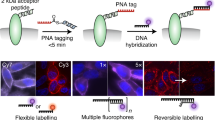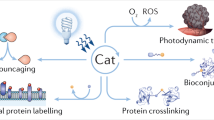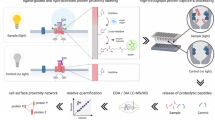Abstract
Bioorthogonal cycloaddition reactions between tetrazines and strained dienophiles are widely used for protein, lipid and glycan labelling because of their extremely rapid kinetics. However, controlling this chemistry in the presence of living mammalian cells with a high degree of spatial and temporal precision remains a challenge. Here we demonstrate a versatile approach to light-activated formation of tetrazines from photocaged dihydrotetrazines. Photouncaging, followed by spontaneous transformation to reactive tetrazine, enables live-cell spatiotemporal control of rapid bioorthogonal cycloaddition with dienophiles such as trans-cyclooctenes. Photocaged dihydrotetrazines are stable in conditions that normally degrade tetrazines, enabling efficient early-stage incorporation of bioorthogonal handles into biomolecules such as peptides. Photocaged dihydrotetrazines allow the use of non-toxic light to trigger tetrazine ligations on living mammalian cells. By tagging reactive phospholipids with fluorophores, we demonstrate modification of HeLa cell membranes with single-cell spatial resolution. Finally, we show that photo-triggered therapy is possible by coupling tetrazine photoactivation with strategies that release prodrugs in response to tetrazine ligation.

This is a preview of subscription content, access via your institution
Access options
Access Nature and 54 other Nature Portfolio journals
Get Nature+, our best-value online-access subscription
$29.99 / 30 days
cancel any time
Subscribe to this journal
Receive 12 print issues and online access
$259.00 per year
only $21.58 per issue
Buy this article
- Purchase on Springer Link
- Instant access to full article PDF
Prices may be subject to local taxes which are calculated during checkout




Similar content being viewed by others
Data availability
The data that support the findings of this study are available within the paper and its Supplementary Information. Source data are provided with this paper.
References
Saxon, E. & Bertozzi, C. R. Cell surface engineering by a modified Staudinger reaction. Science 287, 2007–2010 (2000).
Prescher, J. A., Dube, D. H. & Bertozzi, C. R. Chemical remodelling of cell surfaces in living animals. Nature 430, 873–877 (2004).
Devaraj, N. K. The future of bioorthogonal chemistry. ACS Cent. Sci. 4, 952–959 (2018).
Blackman, M. L., Royzen, M. & Fox, J. M. Rapid tetrazine ligation: fast bioconjugation based on inverse-electron-demand Diels–Alder reactivity. J. Am. Chem. Soc. 130, 13518–13519 (2008).
Devaraj, N. K., Weissleder, R. & Hilderbrand, S. A. Tetrazine-based cycloadditions: application to pretargeted live cell imaging. Bioconjug. Chem. 19, 2297–2299 (2008).
Oliveira, B. L., Guo, Z. & Bernardes, G. J. L. Inverse electron demand Diels-Alder reactions in chemical biology. Chem. Soc. Rev. 46, 4895–4950 (2017).
Nguyen, S. S. & Prescher, J. A. Developing bioorthogonal probes to span a spectrum of reactivities. Nat. Rev. Chem. 4, 476–489 (2020).
Elliott, T. S. et al. Proteome labeling and protein identification in specific tissues and at specific developmental stages in an animal. Nat. Biotechnol. 32, 465–472 (2014).
Dong, J. et al. Covalent chemistry on nanostructured substrates enables noninvasive quantification of gene rearrangements in circulating tumor cells. Sci. Adv. 5, eaav9186 (2019).
Liang, D. et al. A real-time, click chemistry imaging approach reveals stimulus-specific subcellular locations of phospholipase D activity. Proc. Natl Acad. Sci. USA 116, 15453–15462 (2019).
Agarwal, P., Beahm, B. J., Shieh, P. & Bertozzi, C. R. Systemic fluorescence imaging of zebrafish glycans with bioorthogonal chemistry. Angew. Chem. Int. Ed. 54, 11504–11510 (2015).
Carlson, J. C. T., Mikula, H. & Weissleder, R. Unraveling tetrazine-triggered bioorthogonal elimination enables chemical tools for ultrafast release and universal cleavage. J. Am. Chem. Soc. 140, 3603–3612 (2018).
Versteegen, R. M. et al. Click-to-release from trans-cyclooctenes: mechanistic insights and expansion of scope from established carbamate to remarkable ether cleavage. Angew. Chem. Int. Ed. 57, 10494–10499 (2018).
Li, H., Conde, J., Guerreiro, A. & Bernardes, G. J. L. Tetrazine carbon nanotubes for pretargeted in vivo ‘click-to-release’ bioorthogonal tumour imaging. Angew. Chem. Int. Ed. 59, 16023–16032 (2020).
Li, J., Jia, S. & Chen, P. R. Diels–Alder reaction-triggered bioorthogonal protein decaging in living cells. Nat. Chem. Biol. 10, 1003–1005 (2014).
Ji, X. et al. Click and release: bioorthogonal approaches to ‘on-demand’ activation of prodrugs. Chem. Soc. Rev. 48, 1077–1094 (2019).
Czuban, M. et al. Bio-orthogonal chemistry and reloadable biomaterial enable local activation of antibiotic prodrugs and enhance treatments against Staphylococcus aureus infections. ACS Cent. Sci. 4, 1624–1632 (2018).
Wu, K. et al. Click activated protodrugs against cancer increase the therapeutic potential of chemotherapy through local capture and activation. Chem. Sci. 12, 1259–1271 (2021).
Patterson, G. H. & Lippincott-Schwartz, J. A photoactivatable GFP for selective photolabeling of proteins and cells. Science 297, 1873–1887 (2002).
Kumar, G. S. & Lin, Q. Light-triggered click chemistry. Chem. Rev. 121, 6991–7031 (2021).
Kumar, P., Jiang, T., Li, S., Zainul, O. & Laughlin, S. T. Caged cyclopropenes for controlling bioorthogonal reactivity. Org. Biomol. Chem. 16, 4081–4085 (2018).
Mayer, S. V., Murnauer, A., von Wrisberg, M. K., Jokisch, M. L. & Lang, K. Photo-induced and rapid labeling of tetrazine-bearing proteins via cyclopropenone-caged bicyclononynes. Angew. Chem. Int. Ed. 58, 15876–15882 (2019).
Hockberger, P. E. A history of ultraviolet photobiology for humans, animals and microorganisms. Photochem. Photobiol. 76, 561–579 (2002).
Versteegen, R. M., Rossin, R., ten Hoeve, W., Janssen, H. M. & Robillard, M. S. Click to release: instantaneous doxorubicin elimination upon tetrazine ligation. Angew. Chem. Int. Ed. 52, 14112–14116 (2013).
Zhang, H. et al. Rapid bioorthogonal chemistry turn-on through enzymatic or long wavelength photocatalytic activation of tetrazine ligation. J. Am. Chem. Soc. 138, 5978–5983 (2016).
da Costa, S. R., da Costa Monteiro, M., da Silva Júnior, F. M. R. & Sandrini, J. Z. Methylene blue toxicity in zebrafish cell line is dependent on light exposure. Cell Biol. Int. 40, 895–905 (2016).
Hansen, M. J., Velema, W. A., Lerch, M. M., Szymanski, W. & Feringa, B. L. Wavelength-selective cleavage of photoprotecting groups: strategies and applications in dynamic systems. Chem. Soc. Rev. 44, 3358–3377 (2015).
Corrie, J. E. T., Barth, A., Munasinghe, V. R. N., Trentham, D. R. & Hutter, M. C. Photolytic cleavage of 1-(2-nitrophenyl)ethyl ethers involves two parallel pathways and product release is rate-limited by decomposition of a common hemiacetal intermediate. J. Am. Chem. Soc. 125, 8546–8554 (2003).
Zhao, Y. R. et al. New caged coumarin fluorophores with extraordinary uncaging cross sections suitable for biological imaging applications. J. Am. Chem. Soc. 126, 4653–4663 (2004).
An, P., Lewandowski, T. M., Erbay, T. G., Liu, P. & Lin, Q. Sterically shielded, stabilized nitrile imine for rapid bioorthogonal protein labeling in live cells. J. Am. Chem. Soc. 140, 4860–4868 (2018).
Walker, J. W., Reid, G. P., McCray, J. A. & Trentham, D. R. Photolabile 1-(2-nitrophenyl) ethyl phosphate esters of adenine nucleotide analogs. Synthesis and mechanism of photolysis. J. Am. Chem. Soc. 110, 7170–7177 (1988).
Darko, A. et al. Conformationally strained trans-cyclooctene with improved stability and excellent reactivity in tetrazine ligation. Chem. Sci. 5, 3370–3776 (2014).
Slanina, T. et al. In search of the perfect photocage: structure–reactivity relationships in meso-methyl BODIPY photoremovable protecting groups. J. Am. Chem. Soc. 139, 15168–15175 (2017).
Li, Z. et al. Tetrazine-trans-cyclooctene ligation for the rapid construction of 18F labeled probes. Chem. Commun. 46, 8043–8045 (2010).
Selvaraj, R. et al. Tetrazine-trans-cyclooctene ligation for the rapid construction of integrin αvβ3 targeted PET tracer based on a cyclic RGD peptide. Bioorg. Med. Chem. Lett. 21, 5011–5014 (2011).
Pagel, M. Inverse electron demand Diels-Alder (IEDDA) reactions in peptide chemistry. J. Pept. Sci. 25, e3141 (2019).
Jin, C. et al. Phosphorylated lipid-conjugated oligonucleotide selectively anchors on cell membranes with high alkaline phosphatase expression. Nat. Commun. 10, 2704 (2019).
Huang, M. L., Smith, R. A., Trieger, G. W. & Godula, K. Glycocalyx remodeling with proteoglycan mimetics promotes neural specification in embryonic stem cells. J. Am. Chem. Soc. 136, 10565–10568 (2014).
Trigo, F. F., Corrie, J. E. T. & Ogden, D. Laser photolysis of caged compounds at 405 nm: photochemical advantages, localisation, phototoxicity and methods for calibration. J. Neurosci. Methods 180, 9–21 (2009).
Willis, J. C. W. & Chin, J. W. Mutually orthogonal pyrrolysyl-tRNA synthetase/tRNA pairs. Nat. Chem. 10, 831–837 (2018).
Tamura, T. et al. Organelle membrane-specific chemical labeling and dynamic imaging in living cells. Nat. Chem. Biol. 16, 1361–1367 (2020).
Jewett, J. C. & Bertozzi, C. R. Synthesis of a fluorogenic cyclooctyne activated by Cu-free click chemistry. Org. Lett. 13, 5937–5939 (2011).
Kwiatkowski, S. et al. Photodynamic therapy—mechanisms, photosensitizers and combinations. Biomed. Pharmacother. 106, 1098–1107 (2013).
Cao, Z. et al. pH- and enzyme-triggered drug release as an important process in the design of anti-tumor drug delivery systems. Biomed. Pharmacother. 118, 109340 (2019).
Li, J. et al. Palladium-triggered deprotection chemistry for protein activation in living cells. Nat. Chem. 6, 352–361 (2014).
Acknowledgements
Financial support for this work was provided by the National Institutes of Health (DP2DK111801, R01GM123285, R35GM141939 and T32CA009523). We thank W. Xiong and C. Wang for their assistance in measuring the emission spectra of the LED lights. We thank A. Winter and E. Gehrmann for their assistance with the synthesis of BODIPY photocaged dihydrotetrazine. We thank I. Budin and G. Riddihough for providing helpful comments.
Author information
Authors and Affiliations
Contributions
L.L. and N.K.D. conceived the project. L.L. designed and performed the synthetic experiments. L.L. and D.Z. performed microscopy experiments. L.L. and M.J. performed cell experiments. L.L., D.Z., M.J. and N.K.D. analysed the data. L.L. and N.K.D. wrote the manuscript.
Corresponding author
Ethics declarations
Competing interests
The authors declare no competing interests.
Peer review
Peer review information
Nature Chemistry thanks the anonymous reviewer(s) for their contribution to the peer review of this work.
Additional information
Publisher’s note Springer Nature remains neutral with regard to jurisdictional claims in published maps and institutional affiliations.
Supplementary information
Supplementary Information
Materials and methods, Supplementary text, Figs. 1–35, copies of mass and NMR spectra and references 46–51.
Supplementary Data 1
Cell membrane labelling.
Supplementary Data 2
Spatiotemporal cell membrane labelling.
Supplementary Data 3
Light-activated drug delivery by 1a.
Source data
Source Data Fig. 4
Light-activated drug delivery by 1c.
Rights and permissions
About this article
Cite this article
Liu, L., Zhang, D., Johnson, M. et al. Light-activated tetrazines enable precision live-cell bioorthogonal chemistry. Nat. Chem. 14, 1078–1085 (2022). https://doi.org/10.1038/s41557-022-00963-8
Received:
Accepted:
Published:
Issue Date:
DOI: https://doi.org/10.1038/s41557-022-00963-8
This article is cited by
-
Triplet–triplet annihilation photon upconversion-mediated photochemical reactions
Nature Reviews Chemistry (2024)
-
Photo-activatable Reagents for Bioorthogonal Ligation Reactions
Topics in Current Chemistry (2024)



